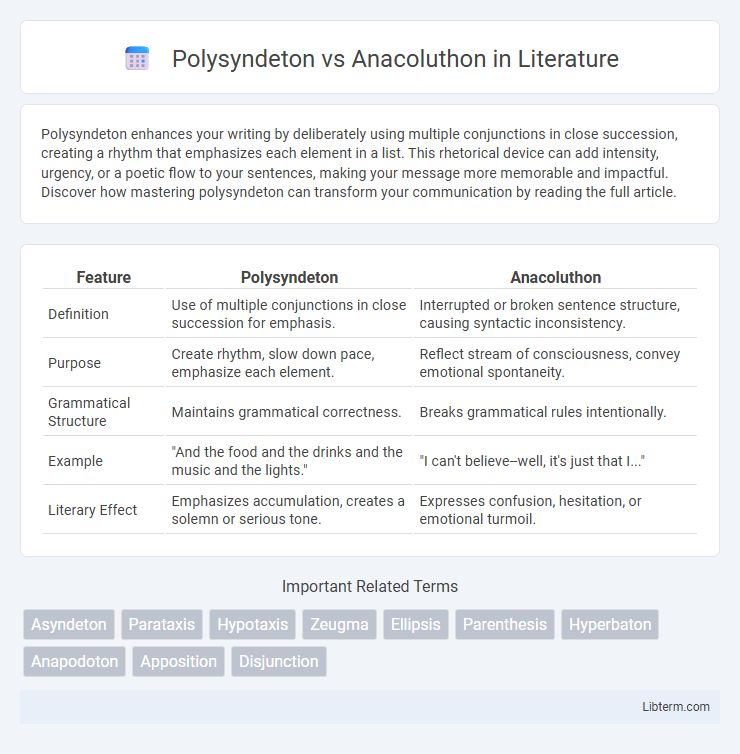Polysyndeton enhances your writing by deliberately using multiple conjunctions in close succession, creating a rhythm that emphasizes each element in a list. This rhetorical device can add intensity, urgency, or a poetic flow to your sentences, making your message more memorable and impactful. Discover how mastering polysyndeton can transform your communication by reading the full article.
Table of Comparison
| Feature | Polysyndeton | Anacoluthon |
|---|---|---|
| Definition | Use of multiple conjunctions in close succession for emphasis. | Interrupted or broken sentence structure, causing syntactic inconsistency. |
| Purpose | Create rhythm, slow down pace, emphasize each element. | Reflect stream of consciousness, convey emotional spontaneity. |
| Grammatical Structure | Maintains grammatical correctness. | Breaks grammatical rules intentionally. |
| Example | "And the food and the drinks and the music and the lights." | "I can't believe--well, it's just that I..." |
| Literary Effect | Emphasizes accumulation, creates a solemn or serious tone. | Expresses confusion, hesitation, or emotional turmoil. |
Introduction to Polysyndeton and Anacoluthon
Polysyndeton is a rhetorical device characterized by the deliberate use of multiple conjunctions between clauses or items, enhancing the rhythm and emphasis in a sentence. Anacoluthon involves a sudden break or shift in sentence structure, creating a sense of interruption or spontaneous thought in speech or writing. Both devices serve distinct functions in language: polysyndeton for amplification and anacoluthon for reflecting natural speech patterns or emotional expression.
Defining Polysyndeton: Meaning and Usage
Polysyndeton is a rhetorical device characterized by the deliberate use of multiple conjunctions between clauses or items in a list, enhancing the rhythm and emphasizing each element equally. Commonly found in literary and persuasive texts, polysyndeton amplifies the emotional intensity or urgency by slowing the pace and drawing attention to the abundance of connected concepts. Unlike anacoluthon, which involves an abrupt break or inconsistency in sentence structure, polysyndeton maintains syntactic coherence while enriching textual complexity.
Understanding Anacoluthon: Explanation and Examples
Anacoluthon is a rhetorical device characterized by an abrupt break in the grammatical sequence of a sentence, leading to a sudden change in its structure or thought pattern. Unlike polysyndeton, which deliberately uses multiple conjunctions to slow rhythm and add emphasis, anacoluthon reflects natural speech or emotional turmoil, often seen in literary dialogue to convey confusion or disruption. For example, in Charles Dickens' "Bleak House," a character may start a sentence and then shift direction mid-phrase, illustrating an interrupted thought process that mirrors real-life conversation.
Key Differences Between Polysyndeton and Anacoluthon
Polysyndeton involves the deliberate use of multiple conjunctions between clauses or items, creating a rhythmic and cumulative effect. Anacoluthon is a sudden break in the syntactical structure of a sentence, often leading to an incomplete or disrupted thought. The key difference lies in polysyndeton's consistent grammatical pattern versus anacoluthon's intentional syntactic disruption.
Historical Origins and Literary Context
Polysyndeton, originating from classical Greek rhetoric, features the deliberate repetition of conjunctions to create rhythm and emphasis in texts such as Homer's epic poetry. Anacoluthon, rooted in Latin and Greek linguistic traditions, represents a sudden break or shift in sentence structure commonly used in Roman oratory and modernist literature to depict fragmented thought or speech. Both devices underscore an author's stylistic intentions: polysyndeton enhances narrative flow through cumulative effect, while anacoluthon captures disruption and emotional intensity within literary and rhetorical contexts.
Effects on Tone and Rhythm in Writing
Polysyndeton intensifies tone and rhythm by deliberately overusing conjunctions, creating a sense of urgency or emphasis through a slowed, deliberate pacing that heightens dramatic effect. Anacoluthon disrupts grammatical structure, producing a jarring, unpredictable rhythm that mirrors natural speech and conveys confusion, emotional instability, or spontaneity. Together, these devices manipulate narrative flow to enhance emotional impact and reader engagement through distinct tonal and rhythmic strategies.
Famous Literary Examples of Polysyndeton
Polysyndeton, a rhetorical device characterized by the deliberate use of multiple conjunctions in close succession, appears in famous literary works such as the Bible, where phrases like "and the earth and the stars and the sea" create a rhythmic and emphatic effect. William Faulkner's "As I Lay Dying" uses polysyndeton to convey a character's frantic thoughts with lines like "and it was dark and there was water and the smell of the wood and the sound of the river." In contrast, anacoluthon breaks the expected syntactic flow to reflect confusion or interruption, differing significantly from the ordered repetition found in polysyndeton.
Notable Uses of Anacoluthon in Literature
Notable uses of anacoluthon in literature include James Joyce's "Ulysses," where disrupted syntax reflects stream of consciousness and fragmented thought processes. William Faulkner frequently employs anacoluthon in "The Sound and the Fury" to mirror characters' chaotic mental states. Samuel Beckett's plays also utilize anacoluthon to convey existential confusion and breakdowns in communication.
When to Use Polysyndeton vs Anacoluthon
Polysyndeton is used to create a deliberate rhythm or emphasize the number of items by repeatedly using conjunctions, enhancing the emotional intensity or pacing in a sentence. Anacoluthon serves to reflect natural speech patterns, indicate a sudden shift in thought, or convey confusion and emotional disruption by breaking grammatical continuity. Choose polysyndeton when you want to build momentum or amplify detail, and use anacoluthon to mirror spontaneous, fragmented, or interrupted speech for dramatic or stylistic effect.
Conclusion: Enhancing Writing Through Rhetorical Devices
Polysyndeton intensifies writing by using multiple conjunctions to create rhythm and emphasize ideas, while anacoluthon disrupts syntax to convey urgency or confusion. Mastering both devices enhances rhetorical impact, allowing writers to manipulate tone and pace effectively. Incorporating polysyndeton and anacoluthon strategically strengthens persuasive and creative expression in literature and speeches.
Polysyndeton Infographic

 libterm.com
libterm.com